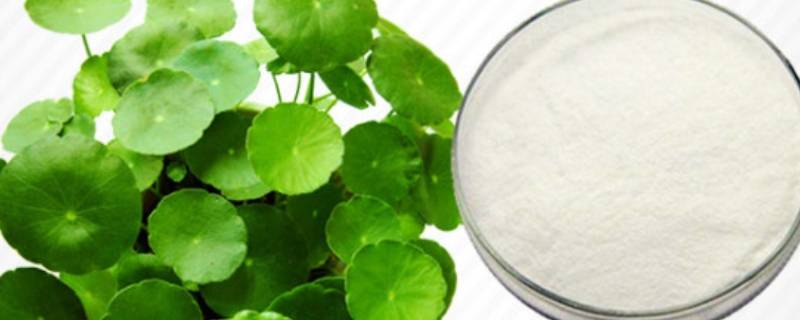Asiaticoside is one of the main components of the triterpenoid saponins of Centella asiatica extract. Modern pharmacological studies have confirmed that Centella Asiatica Glycoside is anti-inflammatory, inhibits scar formation, promotes wound healing, neuroprotection, anti-anxiety, immunomodulation, and other effects.
1. Anti-inflammatory mechanism
Asiaticoside can improve a variety of inflammatory responses, and its mechanism of action is related to the down-regulation of IL-6, IL-1β, TNF-α expression in the NF-κB pathway and inhibition of oxidative stress. It was found that, on the one hand, Centella asiatica glucoside could exert anti-inflammatory effects by inhibiting the NF-κB signaling pathway and down-regulating the expression of nitric oxide (NO), TNF-α, and IL-6; on the other hand, Centella asiatica glucoside could also exert anti-inflammatory effects by regulating the heme oxygenase 1 (HO-1) signaling pathway and inhibiting the production of pro-inflammatory factors and the activity of peroxidase. Centella asiatica glucoside can reduce inflammation induced by hypoxia by inhibiting the NF-κB/p38 signaling pathway, and reduce inflammation induced by hyperoxia by down-regulating the expression of microRNA-155 (miR-155) and up-regulating the expression of suppressor of cytokine signaling protein 1 (SOCS1).
2. Improvement mechanism of liver, lung, and kidney injury
Asiaticoside can improve liver, lung, and kidney injury, and its mechanism of action is related to the inhibition of oxidative stress inflammatory response, improved antioxidant capacity, and so on. Studies have shown that asiaticoside has an ameliorating effect on septic lung injury and septic acute kidney injury. On the one hand, Centella asiatica glucoside can improve lung injury by up-regulating the expression of PPAR-γ and inhibiting the activity of MAPK and NF-κB signaling pathway; on the other hand, Centella asiatica glucoside can improve renal injury by down-regulating the expression of IL-6 in the serum and the expression of iNOS in the kidney tissue. Asiaticoside can improve renal injury in rats with a nephropathy model, and its mechanism of action is related to the up-regulation of mRNA expression of synaptophysin, endorphin, and podophyllotoxin, and the down-regulation of mRNA expression of junctional proteins. The improvement effect of asiaticoside on hyperoxia-induced lung injury was investigated by in vivo and ex vivo experiments and it was found that asiaticoside could play a role in improving lung injury in rats by lowering the serum levels of myeloperoxidase (MPO), malondialdehyde (MDA), and the levels of TNF-α, IL-1β, and IL-6, and by elevating the level of total antioxidant (TAOC) in rats with a model of lung injury. In addition, centella asiatica glucoside could improve liver injury by inhibiting the expression of TNF-α and MAPK.
3. Mechanism of inhibiting scar proliferation and repairing skin damage
Asiaticoside can inhibit scar proliferation and repair skin damage, and its mechanism of action is related to the inhibition of type I and III collagen and the expression of TNF-α, IL-6, IL-1β, as well as the activity of the Wnt/β-catenin signaling pathway, and the up-regulation of the expression of TGF- β1, VEGF, iNOS, MCP-1.
Asiaticoside inhibited the proliferation of scar fibroblasts, and the proliferation of fibroblasts was significantly inhibited when the concentration of the drug was between 0.1 and 1.0 mg/ml, suggesting that asiaticoside reduces the synthesis of extracellular matrix, such as granulation tissue and collagen, and thus reduces the formation of keloid scars through inhibiting fibroblasts; meanwhile, when the concentration of asiaticoside was between 1.0 mg/ml, it could inhibit the expression of mRNA for type I and type III collagen in keloid fibroblasts, and the expression of collagen mRNA for type III collagen was also inhibited. At the same time, at 1.0mg/ml, Centella asiatica inhibited the expression of type I and type III collagen mRNA in scar fibroblasts, indicating that Centella asiatica can inhibit scar formation by decreasing the synthesis of extracellular matrix by decreasing the production of collagen. This suggests that asiaticoside can inhibit collagen production and scar formation by suppressing the function of collagen secretion from overactive fibroblasts.
In vitro experiments showed that the inhibition of the proliferation of scar fibroblasts was related to the inhibition of the expression of proteins related to the RhoA/Rho kinase I (RhoA/ROCKⅠ) signaling pathway, and the down-regulation of cellular autocrine collagen type I and type III and the expression of TGF-β1 mRNA. Relevant studies found that in the ear scar model rabbits, the scar area was gradually reduced with the increase of the administration time, and the mechanism of action was related to the reduction of the expression level of TGF-β1. Asiaticoside can inhibit the formation of proliferative scars in rabbits by down-regulating the expression of type I and III collagen and IL-1β, IL-6, and IL-8 mRNA, and up-regulating the expression of Smad7 and PPARγ mRNA in a dose-dependent manner. Coaxial nanofibers loaded with Centella asiatica glycosides were found to promote the healing of deep II-degree burn wounds in rats by up-regulating the expression of VEGF, PCNA, and endothelial cell adhesion molecule (CD31), and down-regulating the expression of TNF-α and IL-6. It was also found that Centella asiatica glucoside could promote the production of monocyte chemotactic protein 1 (MCP-1) to promote the healing of burn wounds.
Asiaticoside complex could reduce the inflammatory response of the wound in diabetic skin ulcer (DCU) model rats, inhibit the growth of wound bacteria, and promote wound healing, and also up-regulate the expression of VEGF, iNOS, endothelial nitric oxide synthase (eNOS), and CD34; its mechanism of action was related to the down-regulation of the Wnt/β-catenin signaling pathway. Arbitrary flap is a commonly used tool in skin burn and surgical repair, which is used to repair skin defects by selecting an area similar to the damaged skin site as a flap according to the skin defect, and then transferring the flap to the defective area for repair. Some studies have found that Centella asiatica glycosides can increase the area of flap survival in rats, and its mechanism of action is related to the up-regulation of the expression of superoxide dismutase (SOD) and VEGF, and the down-regulation of the expression of inflammatory factors. It was also found that the asiaticoside-sodium alginate repair patch and asiaticoside nano-milk, which were prepared from asiaticoside, had good repair effects on skin damage.
4. Anti-Alzheimer’s disease mechanism of action
Asiaticoside can improve Alzheimer’s disease (AD), and its mechanism of action is related to the inhibition of HUVEC apoptosis, the activity of TLR4/NF-κB signaling pathway, and the expression of the inflammatory factors IL-1, IL-6, and TNF-α. It has been reported in the literature that asiaticoside can alleviate neuroinflammation by decreasing the level of NO and the expression of iNOS mRNA in astrocytes. Asiaticoside ameliorated Aβ-induced vascular endothelial cell (HUVEC) injury, and its mechanism of action was related to the inhibition of apoptosis and the expression of IL-1, IL-6, and TNF-α. The interventional effect of cumquat chloride on Aβ1-42-induced apoptosis in human brain microvascular endothelial cells (hBMECs) revealed that cumquat chloride inhibited hBMECs apoptosis, and its mechanism of action was related to the inhibition of TLR4/NF-κB signaling pathway by inhibition of the expression of TLR4, Myeloid Differentiation Factor 88 (MyD88), Tumor Necrosis Factor Receptor Associated Factor 6 (TRAF6), p-NF-κB p65 protein expression and nuclear translocation of NF-κB as well as the expression of TNF-α and IL-6 were associated. Centella asiatica glucoside can regulate Aβ production before neuropathy, thus preventing the development of AD. Asiaticoside has a protective effect on Aβ1-42-induced HUVEC injury, and its mechanism of action is related to the up-regulation of Bcl-2 expression and the down-regulation of Bax expression. It was found that Centella asiaticoside had a significant reversal effect on 1-methyl-4-phenyl-1,2,3,6-tetrahydropyridine (MPTP)-induced AD and its mechanism of action was related to the elevation of the Bcl-2/Bax ratio. The mechanism of action was related to the elevation of the Bcl-2/Bax ratio. Moreover, the blood-brain barrier penetration ability of cumaricoside is strong, which has the potential for treating neurodegenerative diseases.
5. Anti-fibrosis mechanism of action
Asiaticoside can reduce the degree of fibrosis in various tissues and organs such as the lung, liver, kidney, and heart, and its mechanism of action is related to the down-regulation of the expression of TGF-β1, CTGF, ALT, Asiaticoside T and Hyp. Relevant studies found that when the mass concentration of asiaticoside was 400 μg/mL, it showed inhibitory effects on human embryonic skin fibroblasts and human lung fibroblasts. Asiaticoside can inhibit the production of inflammatory cytokines, reduce the level of TGF-β1mRNA expression, and exert anti-fibrotic effects. Asiaticoside significantly improved renal fibrosis in rats with unilateral ureteral obstruction model, and its mechanism of action was related to the down-regulation of renal mesenchymal connective tissue growth factor (CTGF) and collagen type III (Col III) expression; in addition, Asiaticoside improved myocardial fibrosis after infarction in rats. Asiaticoside could reduce the degree of fibrosis in rat liver tissues, and significantly reduce the levels of ALT and Asiaticoside T in serum and Hyp in liver tissues, indicating that Asiaticoside had an ameliorating effect on immune liver fibrosis. Asiaticoside can improve lung fibrosis caused by bleomycin (BLM) in rats, and its mechanism of action is related to the regulation of the TGF-β1/Smad pathway. Another study found that asiaticoside can also significantly reduce the degree of fibrosis in lung tissue of mice with pulmonary fibrosis model, and its mechanism of action is to improve pulmonary fibrosis by activating the A2AR-assisted cyclic adenosine monophosphate (cAMP)/R-asiaticoside-associated protein 1 (RAP1) signaling pathway.
6. Improve learning and memory ability mechanism
Asiaticoside can improve the learning memory of mice, its mechanism of action is related to the reduction of Aβ deposition in the hippocampus and the up-regulation of synaptophysin (SYN) protein expression; it is also related to the up-regulation of peroxisome proliferator-activated γ-receptor (PPARγ) protein expression, and down-regulation of the expression of inflammatory factors, IL-6, TNF-α, IL-1. Related studies have found that cumquat glucoside is also effective in preventing and controlling diabetic cognitive dysfunction, and its mechanism of action is related to the regulation of oxidative stress and the PI3K/Akt/NF-κB pathway.



Leave A Comment